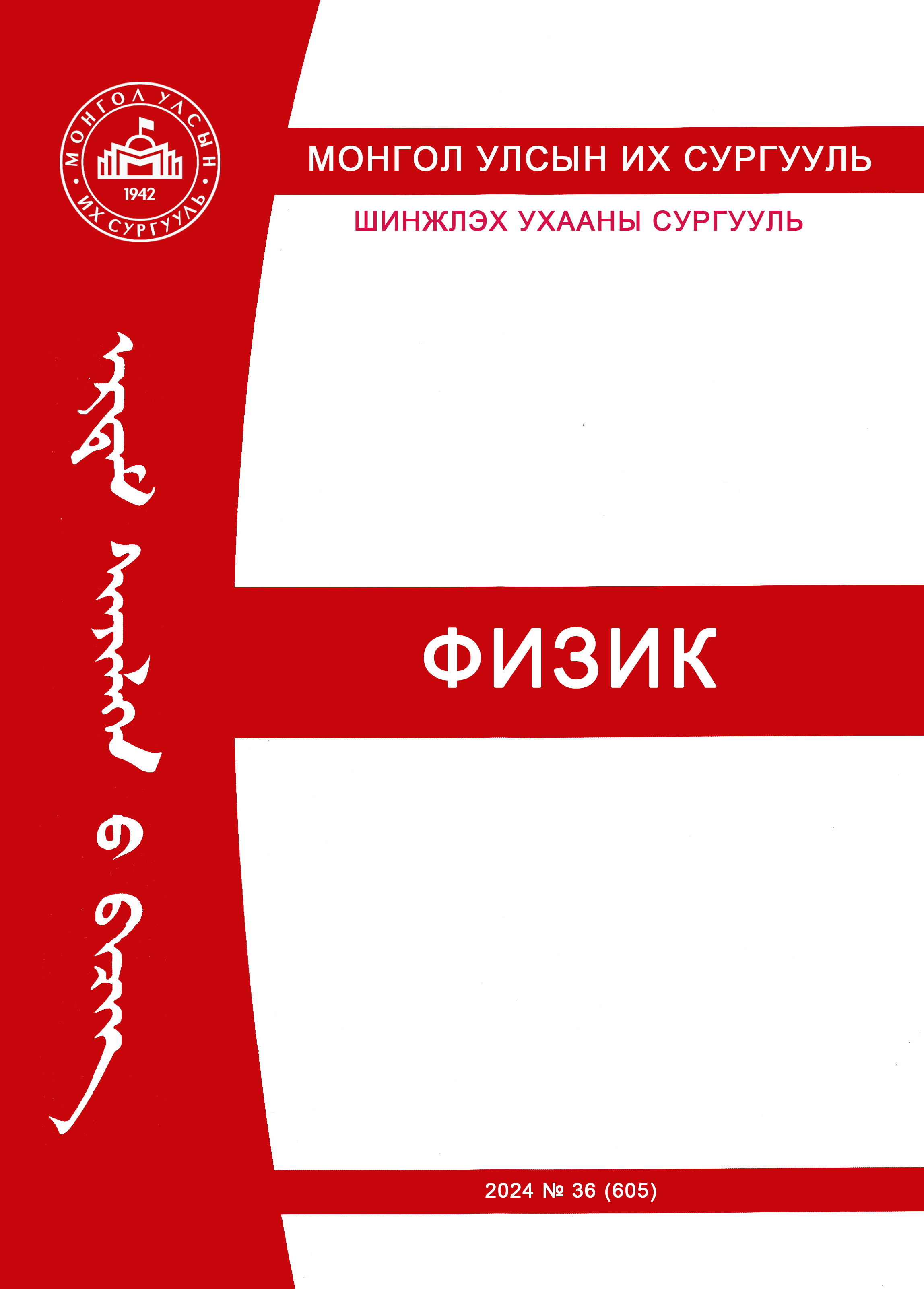Физик технологийн хүрээлэнгийн ажлын байран дахь 222Rn цацраг идэвхийн агууламж
Radon (222Rn) Radioactivity Level at the Institute of Physics and Technology Workplace
DOI:
https://doi.org/10.22353/physics.v36i605.9331Keywords:
Indoor RadonAbstract
Байгалийн цацрагаас хүн амын жилд авч буй цацрагийн шарлагын тунгийн 52%-ийг радоны шарлага эзэлдэг. Радон нь цацраг идэвхт альфа бөөм ялгаруулдаг ба амьсгалын замаар дамжин уушгины хорт хавдар үүсгэх том хүчин зүйл болдог. Энэхүү судалгааны ажлаар Физик Технологийн хүрээлэнгийн ажлын байрны радоны агууламж, жилд авах эффектив тунг тооцоолов. Хэмжилтийг давхар бүрээс нэг өрөөг сонгож, нэмэлтээр зоорийн давхрын ажилчдын хувцас солих өрөө, бодис хадгалах агуулах, коридорт 72 цагийн хугацаатайгаар хэмжилт хийв. Дээрх хугацаанд бүртгэн авсан радоны эзэлхүүнт идэвхийн дундаж утгыг тооцон гаргахад 1 давхарт 58 Бк/м3, 2 давхарт 67 Бк/м3, 3 давхарт 102 Бк/м3, зоорийн давхрын коридор 243 Бк/м3, зоорийн давхрын агуулах 89 Бк/м3, зоорийн давхарт байрлах хувцас солих өрөө 499 Бк/м3 байв. Радоны эзэлхүүнт идэвхээс жилд авах эффектив тунг тооцоолоход зоорийн давхрын хувцас солих өрөө, коридороос бусад өрөө нь Цацрагийн аюулгүй норм үндэсний стандарт, Олон улсын цацрагаас хамгаалах комиссын стандартын дагуу аюулгүйн түвшинд байсан. Харин зоорийн давхарт радоны агууламж илүү өндөр байгаа нь агаарын солилцоо муу, хөрстэй шууд хүрэлцэх, шал, хананы хагарлаар радон хий дамжин орж ирэх, гадна дотно агаарын даралтын зөрүүгээр радон хий зоорийн давхарт сорогдон орж ирэх зэрэгтэй холбоотой. Иймд аливаа барилгын зоорийн давхарт байрлаж байнга оршин суух нь хавдар тусах эрсдэлийг бий болгож байдаг.
[English]
Approximately 52% of the annual radiation dose received by the population from natural radiation sources is attributed to radon exposure. Radon emits radioactive alpha particles and is a significant factor in causing lung cancer through inhalation. In this study, radon concentrations in the building of the Institute of Physics and Technology were measured and used to calculate the effective annual dose received by its employees. Measurements were conducted over 72 hours, selecting one room per floor, with additional measurements in the basement’s changing room, storage room, and corridor. The average radon activity concentrations evaluated within this time frame were as follows: 58 Bq/m³ on the 1st floor, 67 Bq/m³ on the 2nd floor, 102 Bq/m³ on the 3rd floor, 243 Bq/m³ in the basement corridor, 89 Bq/m³ in the basement storage room, and 499 Bq/m³ in the basement changing room. When calculating the effective annual dose based on the radon activity concentrations, all rooms except the basement corridor and changing room were within safe levels according to the National Radiation Safety Norms and the standards of the International Commission on Radiological Protection (ICRP). The elevated radon concentration in the basement is connected to poor air exchange, direct contact with soil, radon gas seeping through cracks in the floor and walls, and differences in indoor and outdoor air pressure drawing radon into the underground floor. Therefore, residing or working continuously in the basement of the building may increase the risk of developing cancer.
Downloads
References
. UNITED NATIONS, Sources and Effects of Ionizing Radiation (Report to the General Assembly), Annex B: Exposures from Natural Radiation Sources, United Nations Scientific Committee on the Effects of Atomic Radiation (UNSCEAR), UN, New York, (2000);
. World Cancer Research Fund, Worldwide cancer data, 2018: https://www.wcrf.org.dietandcancer/cancer-trends/worldwide-cancer-data
. Michaela Kreuzer and James McLaughlin. WHO Guidelines for Indoor Air Quality: Selected Pollutants. Chapter 7: Radon. 2010.
. Makelainen I, et al. Correlations between radon concentration and indoor gamma dose rate, soil permeability and dwelling substructure and ventilation. Science of the Total Environment. 2001;272:283–289.
. Man-made mineral fibres and radon. Lyon: International Agency for Research on Cancer; 1988. (IARC Monographs on the Evaluation of Carcinogenic Risks to Humans, Vol. 43).
. Цацрагийн хамгаалалт, аюулгүй ажилгааны үндсэн дүрэм, Цацрагийн аюулгүйн норм, 2016.
. Lecomte J-F, Solomon S, Takala J, et al. ICRP Publication 126: Radiological Protection against Radon Exposure. Annals of the ICRP. 2014;43(3):5-73.
. ICRP, Occupational Intakes of Radionuclides: Part 3. ICRP Publication 137. Ann. ICRP 46(3/4), 2017.
. Erees, F.S., Yener, G. Radon Levels in New and Old Buildings. In: Baumstark-Khan, C., Kozubek, S., Horneck, G. (eds) Fundamentals for the Assessment of Risks from Environmental Radiation. NATO Science Series, vol 55. Springer, Dordrecht. (1999).
Downloads
Published
How to Cite
Issue
Section
Categories
License
Copyright (c) 2024 Scientific transaction of the National University of Mongolia. Physics

This work is licensed under a Creative Commons Attribution-NonCommercial-ShareAlike 4.0 International License.






